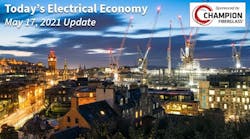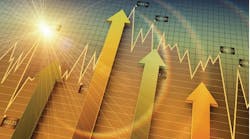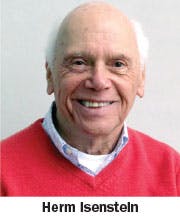Herm Isenstein has analyzed the electrical wholesaling industry’s economic cycles for 30 years as president of DISC Corp., Orange, Conn. Since founding DISC in 1985, he has provided a generation of industry executives with the sales forecasts they need to measure market share and guide their companies. We recently got Herm’s take on the economic cycles that have the most dramatic impact on the electrical market.
Technology has changed many of the products that distributors and manufacturers now sell, but distributors still serve four major end markets – the contractor, industrial, institutional and utility markets. These end markets have different cycles which respond to the cycles in the overall economy.
Even though there have been a whole raft of product changes, and other vast changes in technology, these major segments are very predictable to the extent that we are able to predict the key economic drivers of the electrical industry. If I know with a high degree of certainly how non-residential construction and residential construction are going to change, then I can tell you with a high degree of confidence how each of the key segments served by distributors is going to change and I can dig fairly deep into the geographic layers. That is powerful information in the hands of an intelligent manager.
DISC gave the electrical wholesaling industry ample early warning of the Great Recession. What did you see in your data that enabled you to make that judgment?
The biggest impact for the electrical industry was in 2009 when industry sales tanked by more than 20%. We were seeing things as early as 2007 and 2008 in the overall U.S. economy that were big red flags. We weren’t the only ones seeing it; there were warning signs all over the place. We saw a lot of credit being extended and overextended. This gave rise to a bubble and a lot of people bought into that bubble. When you have a bubble, somebody is going to punch a hole in it and it is going to burst. Then it’s just a question of how fast and how far down it goes.
What set us apart from other people in the electrical industry is how we analyze the industry. We don’t nod our heads when a key economic indicator like construction changes up or down. We are able to take that change and quantify how the demand for electrical distributor products is going to change. We know what makes the industry change and by how much. So when construction plunges by more than 20% as it did in 2009, we know within a few percentage points just how much industry sales are going to change.
We all know that it is not one factor but several factors that influence how the industry is going to behave. We are able to account for each of them in a very measurable way.
The bubble was there for all to see. Our value added is that we know what the key economic drivers are and we know how much the industry will change when those drivers change. The hard part is to do a good job in forecasting the key drivers.
Were there any other economic events or business cycles in your 30 years with DISC that had as big of an impact on the electrical wholesaling industry?
The American economy was coming off a huge burst of inflation in 1974 and the electrical industry had a great year. But that bubble burst. And in 1975 industry sales fell 10% which, at that time, was a record decline and very painful for the industry. We had never experienced that previously. I can recall Kurt Kuhlman, the general manager of my division at GE, saying it was the worst day of his life when he had to lay off so many people. But as with all cycles, we recovered — 1976 and 1977 were decent years — and 1978 sales grew by fully 25%. At the NAED conferences that year everyone was all smiles.
But for distributors and vendors, the tough part is trying to stay ahead of the curve or at least stay with it so you can adequately manage your resources both on the upswing and downswing. That’s the huge challenge facing decision makers in this constructiondriven industry. It’s all about catching the cycle and managing your business on those terms. Our challenge at DISC is to give you the clear warning signals, up or down.
Despite the current dip in oil prices, most economists seem to agree that the United States will be a bigger player in the oil and natural gas markets. If this country doesn’t have to import as much oil and can export more of what it produces, what impact will it have on the electrical market?
That is such a hot issue now. We have laws in place that restrict oil exports and that holds back growth in the American economy. We could be a big-time player in the global energy market. A freer hand to export our surplus oil and gas would promote growth in the American economy and that would, of course, promote growth in the electrical industry.
There is a direct impact on the electrical industry here. Just witness how much electrical industry sales jumped in those areas with the increase in shale exploration. DISC can measure the impact and in our latest April MSA analysis we can see the strong impact of the ups and downs of exploration on electrical industry sales in areas like Fargo, El Paso, Tulsa, etc.
For the electrical industry the battle ground is always at the local level. So I prefer to look at the direct impact of energy exploration in terms of how it directly affects the areas served by distributors directly, not so much at the national level.
And, of course, demand for one industry’s output requires inputs from another industry, creating a rippling effect across all industries. Electrical distributors serve over 900 different industries and, in one way or another, whatever happens in the energy industry is going to affect electrical distributors across the board.
One philosophical note, Nassim Nicholas Taleb made a name for himself with his bestseller, “The Black Swan: The Impact of the Highly Improbable.” As an economist, what are the toughest economic cycles/environments to analyze? What sort of Black Swan economic events keep you up at night?
That’s a very hard question. Black Swan – isn’t that like, expect the unexpected? In the electrical industry it’s all about trying to figure out where you’ve been, where you are now and where you’re going. In this industry there is a paucity of industry data and little or no hard product data. So it’s hard for vendors, reps and distributors to know with certainty what the past looks like and what the future holds. I like to think that DISC has contributed to everyone’s understanding about the industry’s past, present and future. But I’d like to make a solid contribution on the product front and with a little hard data I think I can do a lot with it.
But truthfully, what keeps me up at night is the responsibility I feel whenever I release a new outlook. I recognize many businesses rely on what I project and their profitability as well as the welfare of their employees are influenced in some way. It’s not only a matter of pushing the send button and letting the numbers drop out. I revisit every update three ways to Sunday before I let go. And I know I am going to miss sometimes. I just want to be confident that I am steering the industry in the right direction and we are in the right ball park. I want to continue to do that.
What made you first decide to launch DISC in 1985, and what were some of the early challenges?
While I enjoyed working at GE as an economist and got a lot of positive feedback, I wanted to run my own my business. I decided I would just do it, and if it didn’t work I would just get another job. I struggled at first, but my family, including my wife and five kids, were all very supportive. No one does it alone. I had friends who helped answer many questions for me. It wasn’t the technical stuff, it was how do I market DISC and put it in front of the industry. One of my best friends said to me is, “This is an electronic world, and if you are going to produce all of these numbers, you better put this in an electronic format.” He also said make sure you give customers the opportunity to integrate the forecasts into their own sales territories. This required customized software and it took me several years to develop that software. When I began, Excel didn’t exist. It was Lotus 1-2-3. Access didn’t exist so customized software had to be written in a language that was extremely difficult to master for the functionality I wanted. It took two years before I was able to get a programmer to write sensible code to do what I wanted. It took another year before I was able to package it with my data and put it front of potential customers. I made no money for three years. But people stuck with me.
Bob Murphy, who at that time was with Hubbell Wiring Devices, in was one of the first, if not the first customer I had. He was instrumental in helping me refine the detail geographic data and I am grateful for his help.
Who were some of your industry mentors that helped you get DISC off the ground?
Marv Schylling, NAED president, was enormously helpful to me. His wise comments, I think, made the difference in succeeding or not. The National Association of Electrical Distributors (NAED) under his direction gave me so many chances to get in front of the industry. Some of the other people who helped me along the way were Art Hooper, NAED president; And Ken Hooper, Art’s son and now president of the National Electrical Manufacturers Representatives Association (NEMRA); Panduit’s Jack Caveney, Tristate’s John Waltersdorf, NEMRA’s Hank Bergson and George Young (editor of TED magazine); All-Phase’s Ron Kinney and EESCO’s Stan Weiss were early advocates. I also want to pay tribute to George Ganzenmuller with Electrical Wholesaling.










